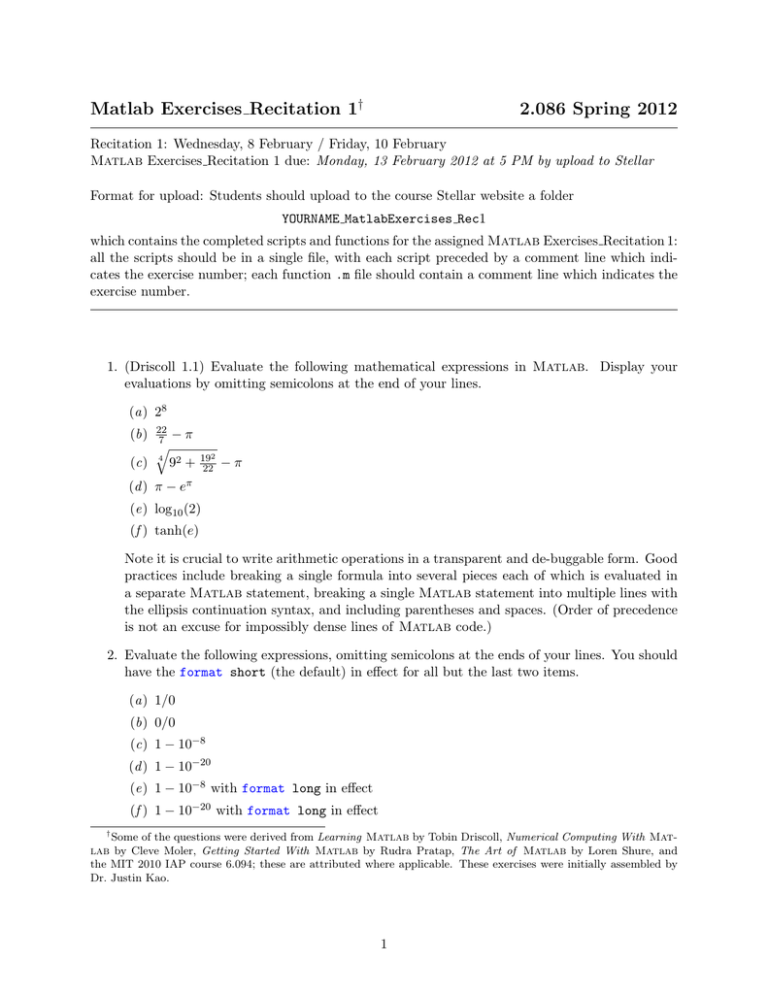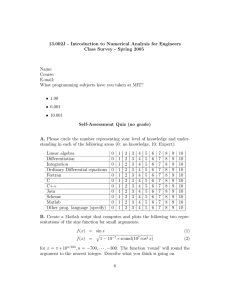Matlab Exercises Recitation 1
advertisement

Matlab Exercises Recitation 1† 2.086 Spring 2012 Recitation 1: Wednesday, 8 February / Friday, 10 February Matlab Exercises Recitation 1 due: Monday, 13 February 2012 at 5 PM by upload to Stellar Format for upload: Students should upload to the course Stellar website a folder YOURNAME MatlabExercises Rec1 which contains the completed scripts and functions for the assigned Matlab Exercises Recitation 1: all the scripts should be in a single file, with each script preceded by a comment line which indi­ cates the exercise number; each function .m file should contain a comment line which indicates the exercise number. 1. (Driscoll 1.1) Evaluate the following mathematical expressions in Matlab. Display your evaluations by omitting semicolons at the end of your lines. (a) 28 (b) (c) 22 7 − 4 π 92 + (d ) π − 192 22 −π eπ (e) log10 (2) (f ) tanh(e) Note it is crucial to write arithmetic operations in a transparent and de-buggable form. Good practices include breaking a single formula into several pieces each of which is evaluated in a separate Matlab statement, breaking a single Matlab statement into multiple lines with the ellipsis continuation syntax, and including parentheses and spaces. (Order of precedence is not an excuse for impossibly dense lines of Matlab code.) 2. Evaluate the following expressions, omitting semicolons at the ends of your lines. You should have the format short (the default) in effect for all but the last two items. (a) 1/0 (b) 0/0 (c) 1 − 10−8 (d ) 1 − 10−20 (e) 1 − 10−8 with format long in effect (f ) 1 − 10−20 with format long in effect † Some of the questions were derived from Learning Matlab by Tobin Driscoll, Numerical Computing With Matlab by Cleve Moler, Getting Started With Matlab by Rudra Pratap, The Art of Matlab by Loren Shure, and the MIT 2010 IAP course 6.094; these are attributed where applicable. These exercises were initially assembled by Dr. Justin Kao. 1 Note that this exercise highlights two different points: there is an internal representation of floating point numbers with only a finite number of bits of precision; there are a number of different formats possible for presentation of floating point numbers. · Background : The Fibonacci sequence is defined by, ⎧ ⎪ ⎨1, Fn = 1, ⎪ ⎩ Fn−1 + Fn−2 , n = 1; n = 2; n ≥ 3. We will take advantage of this sequence in the following exercises (and an exercise for next week). Cartoon by Sidney Harris · 3. Write a script which calculates F20 . Use a for loop. Note that at any given time you need only store the three active members of the sequence, say F_curr, F_old, and F_older, which you will “shuffle” appropriately. Note you can also use some “quick and dirty” plotting to help debug and confirm correct behavior: add a hold on and plot(n,F_curr,'o') in your loop. Note that “quick and dirty” plotting for debugging is different from “presentation” plotting for consumption by others; the latter must contain labels and titles and legends to be useful (we review this in Recitation 2). 4. Write a script which finds N ∗ such that FN ∗ < 1000 and FN ∗ +1 ≥ 1000. Use a while loop. Note the “interior” block of your while loop will be quite similar to the block of your for loop of Exercise 3 but now you must include a (say) Nstar_tmp variable which is initialized outside the loop and incremented each time through the loop. 5. Write a script which finds the sum of the first 40 Fibonacci numbers Fn , 1 ≤ n ≤ 40, for 2 which Fn is divisible by either 2 or 5, 40 t Fn if Fn is divisible by 2 or 5 n=1 0 otherwise . (For example, the first Fibonacci number to be included in the sum will be F3 = 2, and the second Fibonacci number to be included in the sum will be F5 = 5.) Use a for statement similar to Exercise 3 but now add the necessary relational and logical operations, an if, and also a fibsum summation variable which is initialized outside the loop and appropriately incremented inside the loop. You should find the Matlab built-in function mod helpful. 3 MIT OpenCourseWare http://ocw.mit.edu 2.086 Numerical Computation for Mechanical Engineers Fall 2012 For information about citing these materials or our Terms of Use, visit: http://ocw.mit.edu/terms.


